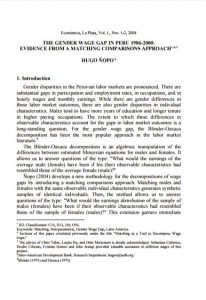The Gender Wage Gap in Peru 1986-2000: Evidence from a Matching Comparisons Approach
| Year | : | 2004 |
|---|---|---|
| Author/s | : | Hugo Ñopo |
| Area/s | : | Employment, productivity and innovation, Ethnicity, gender and citizenship, Methodologies for research and evaluation of policy and programmes |
Ñopo, Hugo (2004). The Gender Wage Gap in Peru 1986-2000: Evidence from a Matching Comparisons Approach. Económica, Departamento de Economía, Facultad de Ciencias Económicas, Universidad Nacional de La Plata, vol. 0(1-2), pages 9-37, January.
Applying the methodology developed in Ñopo (2004), the author analyze the evolution of the gender wage gap in Peru from 1986 to 2000. The advantage of such methodology is two-fold. First, it recognizes that the supports of observable characteristics distributions differ substantially. Second, it provides deeper insights regarding the distribution of the unexplained gender differences in earnings. For the period under analysis, males earn on average 45% more than females. The wage gap is composed of three additive elements: 11% differences in supports, 6% differences in distributions of individual characteristics and 28% unexplainable differences. About half of these unexplainable differences occur in the highest quintile of the wage distribution.






